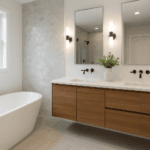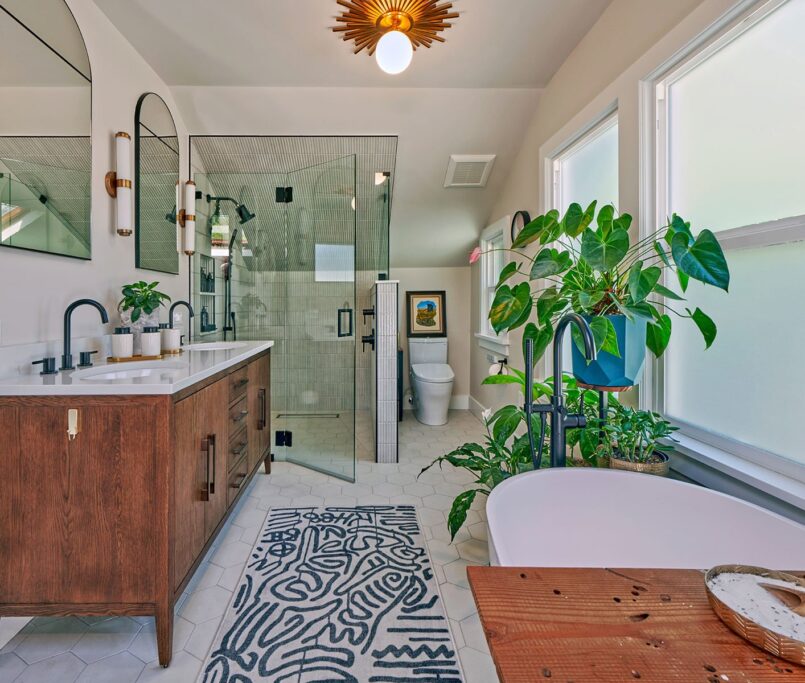Bathroom Remodeling Tips to Prevent Mold and Moisture Problems
Mold and Water Damage Prevention Bathroom Remodeling is more than a buzz phrase; it is the first line of defense against one of the most common and expensive household headaches. A bathroom is a miniature climate zone where hot showers, dripping faucets, and wet floors combine to create perfect breeding grounds for fungi and rot. The trouble stays hidden until a baseboard swells or paint peels, and by then repair bills can eclipse the cost of the original upgrade. Planning moisture control from day one protects your investment, safeguards indoor air quality, and spares you the anxiety of future demolition. This guide delivers a full roadmap, showing how careful design, proven materials, and smart maintenance stop water intrusion at every turn.
Why Bathrooms Collect Moisture So Easily
The average bathroom produces more humidity per square foot than any other room in the house. Steam condenses on cool tile, puddles seep between grout joints, and minor plumbing splashes linger in corners with little air flow. Exhaust fans often underserve the space or shut off too soon, leaving vapor to soak into drywall and framing. Older tile work may lack modern impermeable membranes, making it porous over time. Even a flawless plumbing system eventually faces seal shrinkage because hot and cold cycles expand and contract pipe joints. With so many moisture pathways packed into a small footprint, bathrooms demand extra attention during remodeling to keep hidden voids from turning into damp caverns.
Early Warning Signs of Moisture Trouble
A successful Mold and Water Damage Prevention Bathroom Remodeling strategy starts by recognizing subtle signals. A faint earthy odor that air fresheners cannot mask often means mold is blooming behind finishes. Stubborn discoloration on ceiling drywall below the bathroom hints at slow leaks traveling through joists. Caulk beads that crumble months after application suggest repeated movement from wood swelling. If doors or drawers rub instead of closing smoothly, swollen frames may be the culprit. Darkened grout lines near the floor, peeling wallpaper edges, and sudden increases in allergy symptoms all form a mosaic that points to unseen saturation. Catching these hints early allows swift correction rather than costly overhaul.
Health Risks Linked to Indoor Mold
Spores released by bathroom mold become airborne every time you step on the mat or flush the toilet, drifting into lungs where they spark irritation. People with asthma face increased attacks, while small children and seniors may develop chronic coughs. Some mold species create mycotoxins that trigger headaches and fatigue, eroding daily productivity. Constant exposure keeps the immune system on alert, which studies link to heightened inflammation. Because bathrooms are compact, spore concentrations climb quickly, making even short visits risky. Blocking moisture not only saves timber and tile, it preserves respiratory health for everyone in the household.
Foundational Principles for Moisture Defense
Effective Mold and Water Damage Prevention Bathroom Remodeling follows three pillars. First, stop water before it penetrates by installing continuous waterproof barriers across every wet surface. Second, direct incidental moisture to drains with proper slopes and sealed transitions. Third, evacuate lingering humidity through mechanical ventilation sized for the room. When these steps work together, airborne vapor leaves quickly, standing water finds a safe path out, and structural components stay dry. Missing any pillar breaks the chain, giving moisture a chance to hide and spread.
Selecting Materials That Outsmart Moisture
Materials are the hardware of your defense plan. Rigid cement boards resist swelling and provide a stable base for tile. Liquid-applied waterproofing rolled over seams creates an unbroken shell. Sheet membranes embedded under mortar beds guide water directly to the drain. Epoxy or urethane grout repels stains and never needs sealing. Use silicone caulk at all plane changes because it stretches with heat cycles without cracking. Paint walls outside the splash zone with mold inhibiting additives. Finally, choose solid surface or acrylic shower bases to remove mortar voids where water could collect.
Checklist of Moisture-Smart Components
- Cement backer board for all wet walls
- Liquid membrane covering seams and fasteners
- Sheet membrane on floors including under vanity
- Epoxy grout for tile joints
- Pure silicone caulk at corners and fixture edges
Ventilation and Humidity Management
Stopping liquid water is only half the fight; airborne vapor must exit swiftly. Select an exhaust fan that moves air eight times the room volume every hour and connects to an outdoor vent, never an attic. Fit the fan with a humidity sensor that keeps it running until the relative level falls below fifty percent. If building codes allow, add a small operable window for extra airflow. Position heater vents away from the fan intake so warm moist air does not bypass extraction. By reducing the time humidity hangs in the room, you starve mold of the damp environment it needs.
Plumbing and Leak Testing Protocols
Any pipe failure undermines the most meticulous surface protection. Before closing walls, pressure test new lines at one and a half times normal pressure for a minimum of two hours. Wrap supply stub outs with gasket sleeves to block capillary action. Install shutoff valves at each fixture for easy future repairs. Use stainless braided connectors instead of rubber hoses which can split under temperature swings. Verify that shower pan weep holes remain clear and that drain flanges are fully embedded in sealant. Careful plumbing practice ensures that water stays in pipes until it reaches the drain.
Maintenance Habits to Lock In Success
Long term Mold and Water Damage Prevention Bathroom Remodeling depends on simple routines once construction ends. Wipe down glass and tile after showers to remove surface moisture. Run the fan during bathing and for twenty extra minutes. Inspect caulk lines every six months and replace at the first hint of lift or discoloration. Keep a digital hygrometer on the vanity and adjust fan timers if readings often exceed sixty percent. Clean hair traps regularly so standing water never forms above the drain. Small habits performed consistently keep the original waterproofing system working flawlessly year after year.

Conclusion
Moisture may be inevitable in a bathroom, but damage is not. By following proven design principles, choosing the right materials, and adopting smart maintenance habits, you can block mold before it grows and keep water exactly where it belongs. If you are ready to remodel with confidence and want guidance from builders who treat moisture control as mission critical, reach out to Grand Building Construction for a complimentary consultation and let us help you craft a bathroom that stays beautiful, healthy, and bone dry.




